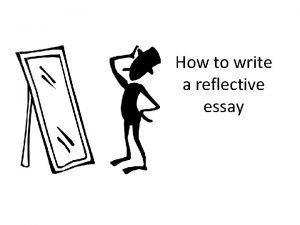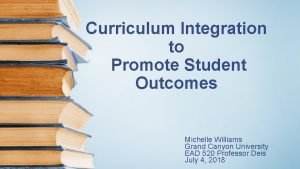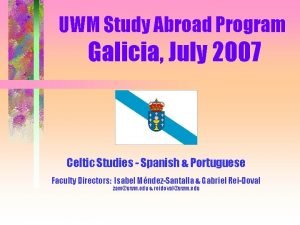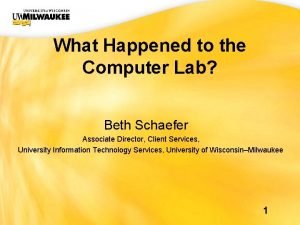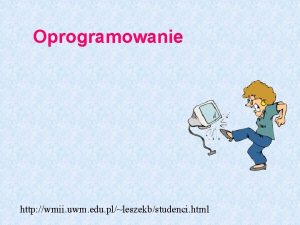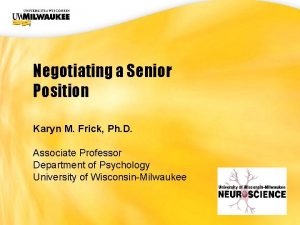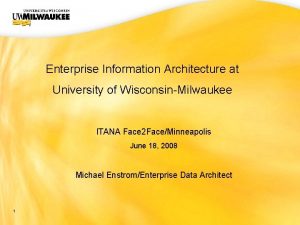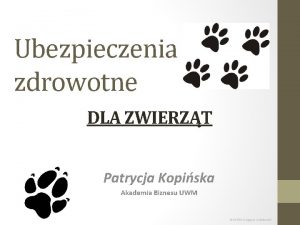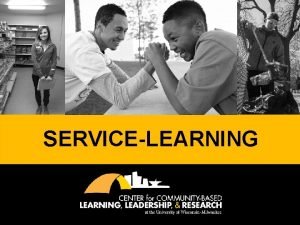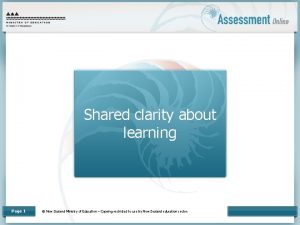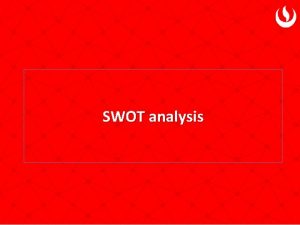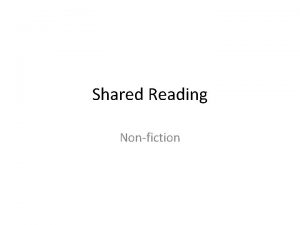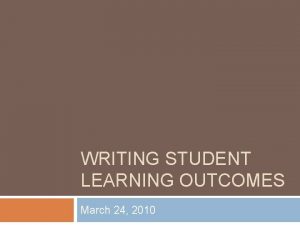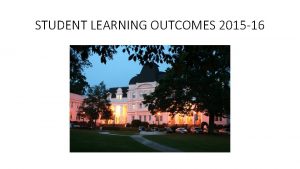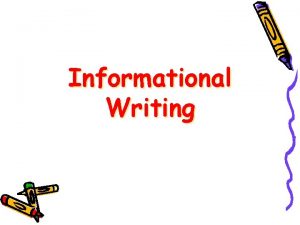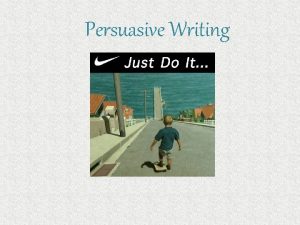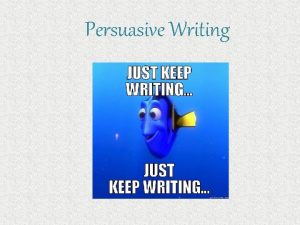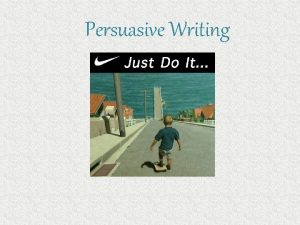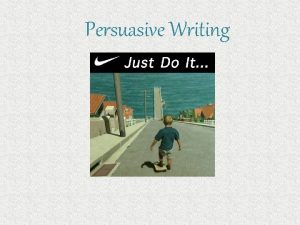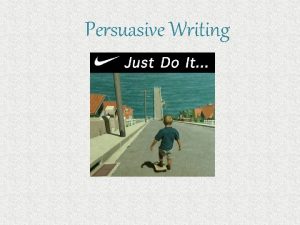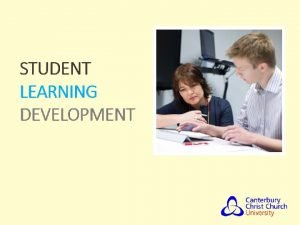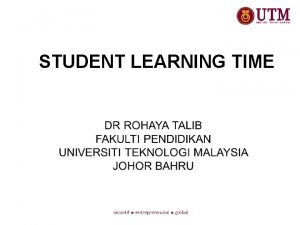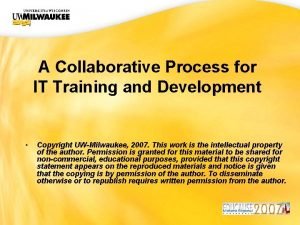SHARED LEARNING OUTCOMES WRITING LEARNING OUTCOMES UWM STUDENT



























- Slides: 27

SHARED LEARNING OUTCOMES: WRITING LEARNING OUTCOMES UWM STUDENT AFFAIRS

PART II BY THE END OF THIS SESSION, YOU WILL BE ABLE TO… Apply Bloom and Fink’s Taxonomies of Learning to write Unit and Program level learning outcomes Align Program/event/services with Unit level learning outcomes.


UW System Shared Learning Goals (2008) • Knowledge of Human Cultures and the Natural World including breadth of knowledge and the ability to think beyond one’s discipline, major, or area of concentration. This knowledge can be gained through the study of the arts, humanities, languages, sciences, and social sciences. • Critical and Creative Thinking Skills including inquiry, problem solving, and higher order qualitative and quantitative reasoning. • Effective Communication Skills including listening, speaking, reading, writing, and information literacy. • Intercultural Knowledge and Competence including the ability to interact and work with people from diverse backgrounds and cultures; to lead or contribute support to those who lead; and to empathize with and understand those who are different than they are. • Individual, Social and Environmental Responsibility including civic knowledge and engagement (both local and global), ethical reasoning, and action.

UW System Shared Learning Goals (SLGs) Each Student Affairs Unit Aligns with SLGs DRAFTs UNIT LGs Programs w/in Units write Program/Event LGs-Match to Unit LGs Units Revise Unit LGs


Ex: Women’s Ctr. SA UNITS STUDENT AFFAIRS DIVISION MAP Map Strongly Embedded Moderately Embedded Weakly Embedded

Women’s Ctr. Unit Level SLG Map Unit A: _________________________

TWO TAXONOMIES OF LEARNING §Bloom’s Taxonomy §Fink’s Taxonomy of Significant Learning Experiences Intentionality Congruency Transparency

By the end of the program, what will students be able to do? Week 1 Days Minutes Your Program Design Blueprint The learning outcomes set the parameters for the content, activities, experiences. They are the blueprint upon which you will ground the rest of the design decisions.

STUDENT AFFAIRS: SITUATE THE OUTCOME FOR WHAT “COMES OUT” OF THE EVENT OR PROGRAM, NOT WHAT IS EXPERIENCED DURING IT. Example: Class participants (Audience) in the Alcohol Awareness class (Condition) offered by Health Education will increase their knowledge of alcohol dangers and safety strategies (Behavior) and be able to state three warning signs of problem drinking and three strategies for avoiding alcohol abuse (Demonstration) aft

BY THE END OF THE PROGRAM OR EVENT… STUDENTS WILL BE ABLE TO: During the event or program… Meet a variety of students from other cultures. After the event or program… Initiate conversation and socialize with students from different cultures and who practice different cultural values.

Unpacking learning The verbs on the right are helpful for writing specific course learning outcomes. They can help you to determine specific learning outcomes for each program, activity, or event within your Unit or your Unit itself. Intentionality Evaluation judge, recommend, critique, justify Synthesis create, design, invent, hypothesize, develop categorize, compare, contrast, analyze separate Analysis Application use, compute, solve, apply, construct Comprehension explain, summarize, describe, illustrate Knowledge write, list, label, name, state, define Bloom’s Taxonomy: Very cognition oriented

Bloom’s Taxonomy is one of many taxonomies of learning. It can be a helpful tool in unpacking what we mean by “learning. ” Bloom separates learning into six levels of increasing cognitive complexity – starting with the lowest level – knowledge, or what we commonly think of as memorization or rote learning. The better we are able to articulate what it is we want students to be able to do by the end of the program, event, or experience, the easier it is to select specific programs, identify partners within the unit and across units, and determine methods to assess the student learning.

Creating Learning-centered Outcomes Use active verbs and start with the phrase: Intentionality By the end of the program, students will be able to… Argue Describe Interpret Compare Devise Perform Compose Establish Provide Conduct Evaluate Select Contrast Examine Solve Construct Explain Synthesize Weigh Identify Define Write Formulate Demonstrate


Fink’s Taxonomy of Significant Learning

FINK’S TAXONOMY OF SIGNIFICANT LEARNING EXPERIENCES Fink’s Taxonomy 1 is a newer effort to capture a wider range of learning experiences that go beyond the cognitively based levels of learning prescribed by Bloom. As you can see, the various levels cognitive learning outlined by Bloom may be similar to the Foundational, Application, and Integration categories on the left side of the diagram. Many disciplines and institutions are focusing attention to other dimensions of the human experience and learning potential that are better matched to Fink’s Human Dimension, Caring, and Learning How to Learn. Some consider Fink’s dimensions more holistic and better aligned with the recent AAC&U Essential Learning Outcomes. http: //www. aacu. org/leap/documents/Essential. Outcomes_Chart. pdf Fink, L. Dee. 2003. Creating Significant Learning Experiences: An Integrated Approach to Designing College Which dimensions of Fink’s taxonomy best capture the kind of learning that you hope students will achieve through your program, event, or experience?

Exercise: Taxonomy of Significant Learning L. Dee Fink, Creating Significant Learning Experiences Intentionality IN PAIRS (5 MINUTES) §How does Fink’s taxonomy compare with Bloom’s? §Which domains of learning from Fink or Bloom does your unit aim for students to achieve?

Learner-centered Teaching: By the end of the program, participants will be able to… “…compare female artists to…. ” “…solve community problems…” “…apply the principles of sustainability to their lifestyle decisions…”

Are these learning outcomes? “Students will learn the causes of…” “Students will know several…” “Students will discuss…” “Students will explore…” “Students will be able to understand how…” “Students will be exposed to…” “Students will become familiar” Watch out for vague, passive, and non-specific terms!

LEARNING OUTCOMES VS. LEARNING ACTIVITIES A common mistake when trying to write learning outcomes is to confuse outcomes with the learning activities itself during the program or activity. Activities are means to the learning ends. Example: Students will present…Students will design… If you find yourself doing this, ask yourself, “Why do I want them to do this? ” or “Why is this task or activity important? ” “How will students be different afterwards? ” If you find yourself writing tasks or activities instead of outcomes, look for the learning outcome behind the activity.

BREAK

EXERCISE: DRAFTING UNIT/EVENT LEARNING OUTCOMES By the end of the program/event, students will be able to: 1. 2. 3. 4.

Rubric for Critiquing Unit or Program/Event Learning Outcomes Instructions: Apply the rubric below to review the unit’s or program/event learning outcomes. Highlight the description of each criterion or portion of the description that matches the student learning outcome statement. Multiple levels may be highlighted for each criterion. Criteria Clarity Expert Each learning outcome statement is specific and uses action verbs that identify the kind and level of learning for each competency. Mastering Most of the student learning outcome statements use action verbs that identify the kind and level of learning for most competencies. Minor revisions needed to reduce ambiguity. Measurability Each learning outcome is stated as a singular student performance that is an attitude, a behavior, or knowledge acquired. Alignment Each learning outcome can be linked to at least one UW System Shared Learning Goal. Most learning outcomes are stated as singular student performances of an attitude, a behavior, or knowledge acquired, however, some combine multiple student learning outcomes in one statement. Most learning outcomes can be linked to at least one UW System Shared Learning Goal. Novice Few, one, or no learning outcomes are stated using action verbs. The kind and level of learning for each competency is unclear or missing. Vague words obstruct identifying the learning outcome(s). None of the learning outcomes are stated as singular student performances of an attitude, a behavior, or knowledge acquired. None of the learning outcomes can be linked to the UW System Shared Learning Goals.


 Ncbts
Ncbts What are the domains of ppst
What are the domains of ppst Lesson plan for notice writing
Lesson plan for notice writing How to write reflective essay
How to write reflective essay Learning objectives of email writing
Learning objectives of email writing Sls
Sls Ead 520
Ead 520 Study abroad uwm
Study abroad uwm Uwm cio
Uwm cio Uwm rgi
Uwm rgi Wmii uwm
Wmii uwm Bwz uwm
Bwz uwm Uwm cio
Uwm cio Uwm cio
Uwm cio Akademia biznesu uwm
Akademia biznesu uwm Uwm norris health center
Uwm norris health center Uwm timesheet
Uwm timesheet Wmii uwm
Wmii uwm Uwm ger
Uwm ger Co robi mechatronik
Co robi mechatronik Bu uwm
Bu uwm Shared clarity about learning intentions
Shared clarity about learning intentions Expected outcome example
Expected outcome example Learning outcomes of water cycle
Learning outcomes of water cycle Objective of swot analysis
Objective of swot analysis Objectives of rhymes
Objectives of rhymes Planning goals and learning outcomes
Planning goals and learning outcomes Mesophyll cells
Mesophyll cells



